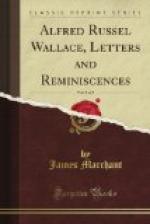D. PRAIN
A.E. SHIPLEY
RAPHAEL MELDOLA
P.A. MACMAHON
JOHN W. JUDD
OLIVER J. LODGE
E.B. POULTON
A. STRAHAN
H.H. TURNER
J. LARMOR
W. RAMSAY
SILVANUS P. THOMPSON
JOHN PERRY
JAMES MARCHANT (Hon. Sec.)
To which the Dean replied:
The Deanery, Westminster, S.W. December 2, 1913.
Dear Mr. Marchant,—I
have pleasure in informing you that I
presented your petition at
our Chapter meeting this morning, and a
glad and unanimous assent
was accorded to it.
I should be glad later on to be informed as to the artist you are employing; and probably it would be as well for him and you and some members of the Royal Society to meet me and the Chapter and confer together upon the most suitable and artistic arrangement or rearrangement of the medallions of the great men of science of the nineteenth century.
Nothing could have been more
satisfactory or impressive than the
document with which you furnished
me this morning. I hope to get
it specially framed.—Yours
sincerely,
HERBERT E. RYLE.
Mr. Bruce-Joy, who had made an excellent medallion of Dr. Wallace during his lifetime, accepted the commission to fashion the medallion for Westminster Abbey, and it was unveiled, by a happy but undesigned coincidence, on All Souls’ Day, November 1 1915, together with medallions to the memory of Sir Joseph Hooker and Lord Lister. In the course of his sermon, the Dean said—and with these words we may well conclude this book:
“To-day there are uncovered to the public view, in the North Aisle of the Choir, three memorials to men who, I believe, will always be ranked among the most eminent scientists of the last century. They passed away, one in 1911, one in 1912, and one in 1913. They were all men of singularly modest character. As is so often observable in true greatness, there was in them an entire absence of that vanity and self-advertisement which are not infrequent with smaller minds. It is the little men who push themselves into prominence through dread of being overlooked. It is the great men who work for the work’s sake without regard to recognition, and who, as we might say, achieve greatness in spite of themselves.
[Illustration: THE WALLACE AND DARWIN MEDALLIONS IN THE NORTH AISLE OF THE CHOIR OF WESTMINSTER ABBEY]
“Alfred Russel Wallace was a most famous naturalist and zoologist. He arrived by a flash of genius at the same conclusions which Darwin had reached after sixteen years of most minute toil and careful observation.... It was a unique example of the almost exact concurrence of two great minds working upon the same subject, though in different parts of the world, without collusion and without rivalry.... Between Darwin and Wallace goodwill and friendship were never interrupted. Wallace’s life was spent in the pursuit of various objects of intellectual and philosophical interest, over which I need not here linger. All will agree that it is fitting his medallion should be placed next to that of Darwin, with whose great name his own will ever be linked in the worlds of thought and science.




